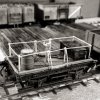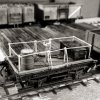F269 GWR Shunting Wagon
Lyndhurstman
Western Thunderer
Dear All,
It is with grateful thanks that we acknowledge your collective interest in our humble and - if we went on current output levels alone - insignificant enterprise.
When it comes to talk of flange depth and rail gauge, I must say that - and forgive me if here I render only my own viewpoint; I would not seek to act with presumption in assigning these views to the volatile personalities constrained behind the walls of the Watkins Wharf Wagon Works workforce - I have great admiration for all artistry in these matters. I value the contribution and finesse of the construction, whatever the Chief Engineer has set down as correct distance between the railheads. Indeed, in my younger days, I had interests in a 4'6 light railway - The Lyng & Lenwade Light - that was intended to serve the communities of the River Wensum in the north of Norfolk. Sadly, due to the withdrawl of support from one of the significant financiers, who suddenly declared the river banks to be unworthy of protracted maintenance (although there were rumours of personal bankruptcy), the scheme folded before a service had been run. In my excursions away from the Works, I have been lucky enough to glimpse from afar the keenly-observed examples railway artistry such as Canada Street and The Brewery, and am in awe of the skills of their Engineers (or - if I may be so bold - Creators). Here at The Works, we are something of 'Johnny Come Lately' in our support of the railways (our initial incarnation was in the manufacture of canal barges and other waterborne craft), and have therefore aligned ourselves with the gauge in place at the Wharf alongside Limehouse Basin, and the tramway that runs off it - as this is where all our work currently comes from. We have had a fair amount of experience in recent times in spreading the wheelsets of the stock acquired via Ernest Bay to accomodate the the additional 9-1/2 "of our "host gauge".
Incidentally, during the War, and in complete secrecy - I have yet to find any mention of the work carried out on the North Bank of the Thames -the sidings at The Wharf made a small contribution to the War Effort by supporting the Artificial Harbours Sub-Committee in hosting the building of caissons required to support the landings in Northern France. In order to undertake this, and facilitate the movement of large quantities of bulding materiel and associated heavy equipment, all track on the quay was upgraded with bullhead checkrails throughout. We have inherited this Wharf in its entirety - having acknowledged special dispensation for access by British Railway engines to all parts of our system (under the command of our pilotmen) - and our best efforts to undertake maintenance on the formations have so far met with little success: I do not know what they put in that cement, but it refuses to surrender to our tools!
Speaking of track maintenance, I enclose a photograph of the current Departmental support vehicle. This little mobile dumping ground started life as a F269 GWR Shunting Wagon. Born in Poole, she spent the majority of her working life in and around Birkenhead. She is currently the sole member of The Works Permanent Way Dept (Foreman In Charge, Walter Broadacre - by night, Beryl's Other Half (or Other Sixteenth as some wags have it - I'm pretty sure we all know who rules the roost in that hen house)) having been enticed away from the clean coastal air of the North West for the sapping fog of the East End of London. We've reworked her a bit, but she's unmistakably Swindon. In her new life with us, she has become used to being pushed into all corners, and loaded with all sorts. She is currently laid up on our Light Repair road awaiting attention to her binding brakes.

I'll just close by answering to Jordan.
I'm very grateful for your questions, although I do wonder if your pint of refreshment was beer - and not something stronger. I have no idea as to the Sell By Date to which you refer. We've only just come off Rationing, and - as far as I'm aware - our food lasts for as long as its saleable. Perhaps you mean 'Selby date' - which I thought was an evening in the company of a North Yorkshire lass?
Until Next Time
Regards To All from all of us here at The Works
Jan Jackson
It is with grateful thanks that we acknowledge your collective interest in our humble and - if we went on current output levels alone - insignificant enterprise.
When it comes to talk of flange depth and rail gauge, I must say that - and forgive me if here I render only my own viewpoint; I would not seek to act with presumption in assigning these views to the volatile personalities constrained behind the walls of the Watkins Wharf Wagon Works workforce - I have great admiration for all artistry in these matters. I value the contribution and finesse of the construction, whatever the Chief Engineer has set down as correct distance between the railheads. Indeed, in my younger days, I had interests in a 4'6 light railway - The Lyng & Lenwade Light - that was intended to serve the communities of the River Wensum in the north of Norfolk. Sadly, due to the withdrawl of support from one of the significant financiers, who suddenly declared the river banks to be unworthy of protracted maintenance (although there were rumours of personal bankruptcy), the scheme folded before a service had been run. In my excursions away from the Works, I have been lucky enough to glimpse from afar the keenly-observed examples railway artistry such as Canada Street and The Brewery, and am in awe of the skills of their Engineers (or - if I may be so bold - Creators). Here at The Works, we are something of 'Johnny Come Lately' in our support of the railways (our initial incarnation was in the manufacture of canal barges and other waterborne craft), and have therefore aligned ourselves with the gauge in place at the Wharf alongside Limehouse Basin, and the tramway that runs off it - as this is where all our work currently comes from. We have had a fair amount of experience in recent times in spreading the wheelsets of the stock acquired via Ernest Bay to accomodate the the additional 9-1/2 "of our "host gauge".
Incidentally, during the War, and in complete secrecy - I have yet to find any mention of the work carried out on the North Bank of the Thames -the sidings at The Wharf made a small contribution to the War Effort by supporting the Artificial Harbours Sub-Committee in hosting the building of caissons required to support the landings in Northern France. In order to undertake this, and facilitate the movement of large quantities of bulding materiel and associated heavy equipment, all track on the quay was upgraded with bullhead checkrails throughout. We have inherited this Wharf in its entirety - having acknowledged special dispensation for access by British Railway engines to all parts of our system (under the command of our pilotmen) - and our best efforts to undertake maintenance on the formations have so far met with little success: I do not know what they put in that cement, but it refuses to surrender to our tools!
Speaking of track maintenance, I enclose a photograph of the current Departmental support vehicle. This little mobile dumping ground started life as a F269 GWR Shunting Wagon. Born in Poole, she spent the majority of her working life in and around Birkenhead. She is currently the sole member of The Works Permanent Way Dept (Foreman In Charge, Walter Broadacre - by night, Beryl's Other Half (or Other Sixteenth as some wags have it - I'm pretty sure we all know who rules the roost in that hen house)) having been enticed away from the clean coastal air of the North West for the sapping fog of the East End of London. We've reworked her a bit, but she's unmistakably Swindon. In her new life with us, she has become used to being pushed into all corners, and loaded with all sorts. She is currently laid up on our Light Repair road awaiting attention to her binding brakes.

I'll just close by answering to Jordan.
I'm very grateful for your questions, although I do wonder if your pint of refreshment was beer - and not something stronger. I have no idea as to the Sell By Date to which you refer. We've only just come off Rationing, and - as far as I'm aware - our food lasts for as long as its saleable. Perhaps you mean 'Selby date' - which I thought was an evening in the company of a North Yorkshire lass?
Until Next Time
Regards To All from all of us here at The Works
Jan Jackson





 yes, as Mr D Star Esq divulged, I did say I'd have to read the thread slowly several times. Obviously I missed the date bit so didn't read it carefully enough
yes, as Mr D Star Esq divulged, I did say I'd have to read the thread slowly several times. Obviously I missed the date bit so didn't read it carefully enough 






